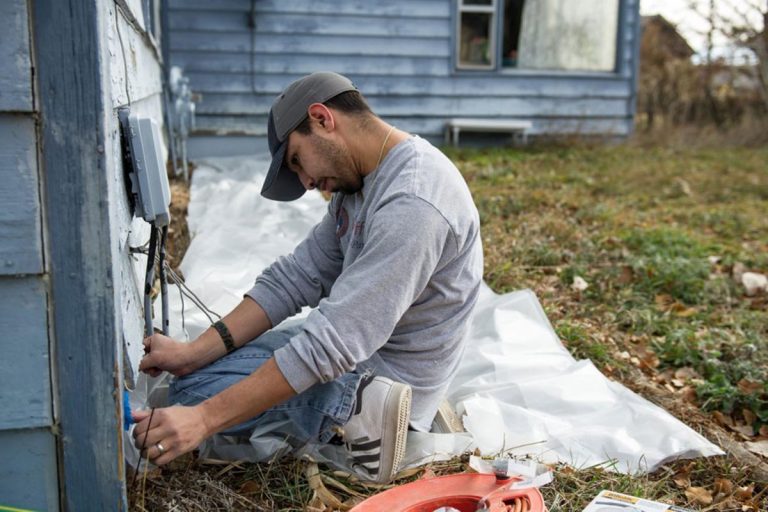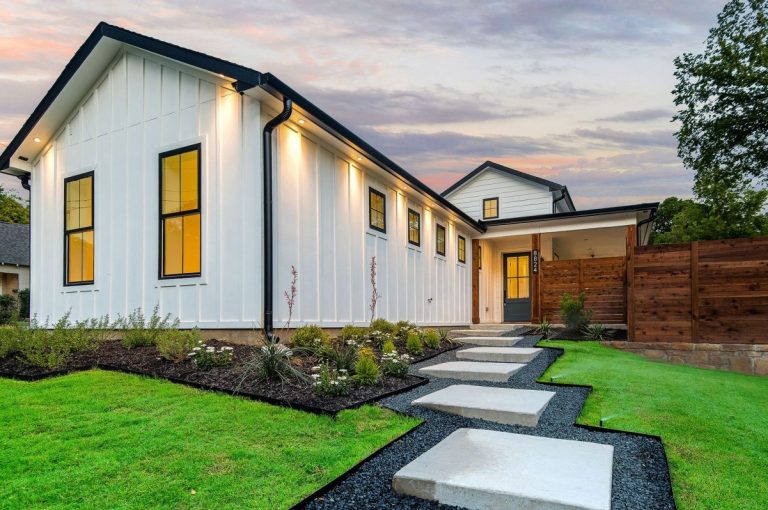As concerns about global warming and environmental impact continue to grow, building an energy efficient home has become a priority for many home buyers. Not only can an energy efficient home save money on energy bills, but it also reduces the amount of energy needed to heat, cool, and power the home, which in turn reduces our reliance on fossil fuels and other non-renewable energy sources.
In this article, we’ll explore the must-haves when building energy efficient homes and tips for designing the most energy efficient house.
What Makes a House Energy Efficient?
Energy efficient homes are designed to use as little energy as possible to maintain a comfortable temperature inside. This is achieved by reducing heat loss through the building envelope (walls, windows, and roof) and minimizing air leaks, which can cause heated or cooled air loss.
The most energy efficient house is one that is designed to consume as little energy as possible and to use renewable energy sources like solar panels to generate electricity or heat water.
Must-Haves When Building an Energy-Efficient Home

To make energy efficient homes, the following are a must have:
Application of Continuous Insulation
Continuous insulation is a type of insulation that is applied to the exterior walls of the home, providing a layer of protection against heat transfer. It helps to prevent thermal bridges, which are areas where heat can escape more easily, and can also reduce air leaks. This insulation is a must-have when building an energy saving home.
The appropriate level of insulation, or R-value, for a home, is determined by several factors, such as its location, type of heating and cooling systems, the areas of the house requiring insulation, and building codes at the state and local levels. For instance, the 2018 IECC sets R-value requirements for wood-frame walls in all eight US climate zones ranging from 13 to 20. According to the building codes, the R-values for mass walls are also subject to variation, ranging from 3 to 21.
Advanced Water Cooling and Heating System
Heating and cooling system account for a significant portion of energy use in the home. The heating costs can impact your bills. Therefore, installing an efficient heating and cooling system is crucial to making your home energy efficient and save energy.
One option is to use a geothermal heat pump, which uses the earth’s natural temperature to heat and cool the home. Another option is to install a high-efficiency HVAC system, which can reduce energy consumption by up to 20%. You can install energy star certified appliances to get the most out of your investment.
Airtight Windows for Energy efficient Houses
Windows are an important component of an energy efficient home, as they can account for a significant amount of heat loss. Airtight windows are a must-have, as they can prevent air leaks and help to maintain a consistent temperature inside the home.
Energy star certified windows are a viable alternative, as they are designed to let fresh air inside and save energy, and reduce heating and cooling costs.
Creating an Air and Moisture Barrier
Air and moisture barriers are essential components of an energy efficient home, as they can help to prevent air leaks and moisture buildup. This can be achieved through the use of insulated concrete forms or other building materials that are designed to create an airtight seal.
Tips to Make Energy Efficient Homes

Incorporate Ample Daylighting
One of the easiest and most cost-effective ways to increase your home energy efficiency is to incorporate ample natural lighting. This means using natural light to illuminate your home during the day, reducing the need for artificial lighting. Not only does this save money on electricity bills, but it also has a positive impact on your mental and physical health.
There are several ways to incorporate energy efficient lighting into your home design. First, consider the placement of windows and skylights. Place windows on the south-facing walls of your home to maximize sunlight exposure.
Additionally, use skylights to bring natural light into areas of the home that don’t have access to windows. Second, choose light-colored or reflective surfaces for walls, ceilings, and floors to help bounce natural light around the room.
Use Cool Roofs for Energy Efficiency

Cool roofs are an eco-friendly option for building an energy-saving home. Cool roofs are designed to reflect sunlight and absorb less heat, which helps to reduce the amount of energy needed to cool the home. Cool roofing can be made from a variety of materials, including metal, tile, and shingles.
Recycled materials are also a great choice for building an energy efficient home. They can be used for framing, flooring, countertops, and more. Using these materials helps to reduce waste and lower the environmental impact of your home.
In addition, some of these materials, like steel, can be more durable and longer-lasting than traditional building materials.
Utilize Renewable Energy Sources
Energy sources like solar panels, wind turbines, and geothermal systems are becoming more popular as homeowners seek to reduce their carbon footprint and bills.
Solar energy, in particular, has become more affordable and efficient in recent years, making them a popular choice for homeowners. Installing solar panels on your roof can generate clean electricity and reduce reliance on non-renewable power sources. It can save your natural gas bills.
Wind turbines and geothermal systems can also be used to generate clean energy for your home. While these systems may require a larger initial investment than solar panels, they can provide significant long-term energy savings.
Address Air Leakage and Insulation
Air leaks and poor insulation can cause significant energy loss in the home. Addressing these issues is crucial to making your home more energy efficient. Air leaks can occur around windows, doors, and other openings in the home, allowing heated or cooled air to escape.
Poor insulation can cause heat transfer between the interior and exterior of the home, leading to increased energy use and costs. It can increase the energy efficiency of your home.
To address air leaks and insulation, it’s important to ensure that your home has proper insulation and that air leaks are sealed. This can be achieved through the use of continuous insulation, airtight windows and doors, and proper sealing of ductwork and other openings.
An energy audit can help identify areas of the home that are experiencing air leaks and insulation issues.
Make Use of Your Shades
Windows are an important feature of any home, providing light and ventilation. However, they can also be a significant source of heat gain and loss, especially in areas with extreme heat or cold.
Fortunately, there are ways to reduce the energy impact of your windows by using shades and other window treatments. They are effective to increase the energy efficiency of your home.
Shades are a simple and effective way to control the amount of sunlight entering your home. During the hottest parts of the day, closing your shades or blinds can help to block out the sun’s heat and keep your home cooler.
In the winter, opening your shades during the day can help to let in light and heat, while closing them at night can help to retain heat inside.
In addition to shades, there are other types of window treatments that can be used to improve the energy efficiency of your home. For example, reflective films can be applied to windows to reflect heat away from home, while insulated curtains can provide additional insulation during the winter months.
Use Less Hot Water
Water heating can be a significant energy expense in the home, accounting for up to 18% of a home’s energy use. Fortunately, there are several ways to use less energy and reduce the amount of hot water you use, which can help to lower your energy bills and reduce your environmental impact.
One simple way to use less hot water is to take shorter showers or baths. You can also reduce hot water use by turning down the temperature of your water heater. For most households, a temperature of 120 degrees Fahrenheit is sufficient for most needs.
Another way to reduce hot water use is to fix leaks and install low-flow fixtures. Leaks can waste a significant amount of hot water over time, while low-flow fixtures like showerheads and faucets can reduce water use by up to 50% without sacrificing water pressure.
Energy Efficient House Design: Top 4 Options
As we continue to face climate change, energy efficiency has become a top priority for homeowners. One way to achieve energy efficiency is through thoughtful home design. Below are the top 5 energy-efficient home designs that can help reduce energy consumption and save on utility bills.
-
Passive Solar Design

Passive solar design is a technique that uses the sun’s energy to heat and cool a home. This design takes advantage of the sun’s light and heat by orienting the house to face south and maximizing the number of windows on that side. This allows for natural heating during the winter months and natural cooling during the summer months and increases energy efficiency.
- Net Zero Homes

Net-zero energy homes are designed to produce as much energy as they consume. These homes typically use a combination of energy-efficient appliances, passive solar design, and renewable power sources like solar panels or wind turbines to generate electricity. The excess energy generated can be sold back to the grid, resulting in a net-zero energy bill.
- Earth-Sheltered Homes

Efficient earth sheltered homes are partially or completely covered by soil or vegetation, which helps to insulate the home and maintain a consistent temperature. This design also helps to protect the home from extreme weather conditions such as high winds and hailstorms. Earth-sheltered homes can be built into hillsides or covered with a green roof to reduce the impact on the environment and lower energy consumption.
- Straw Bale Homes

Straw bale homes use straw bales as the primary building material for the walls. The straw bales provide excellent insulation and can help reduce heating and cooling expenses by up to 75%. Straw bale homes are also fire-resistant, soundproof, and have a low environmental impact.
Final Words
In conclusion, creating an energy-efficient home not only benefits the environment but can also save homeowners a significant amount of money on their bills. By incorporating these tips, such as using cool roofing, utilizing natural resources, addressing air leakage and insulation, making use of shades, and using less hot water, you can improve the overall energy efficiency of your home.
These tips may seem small, but they can have a big impact on the environment and your wallet. Additionally, many of these solutions, such as using renewable power sources or recycled materials, can also contribute to a more sustainable and eco-friendly lifestyle.






